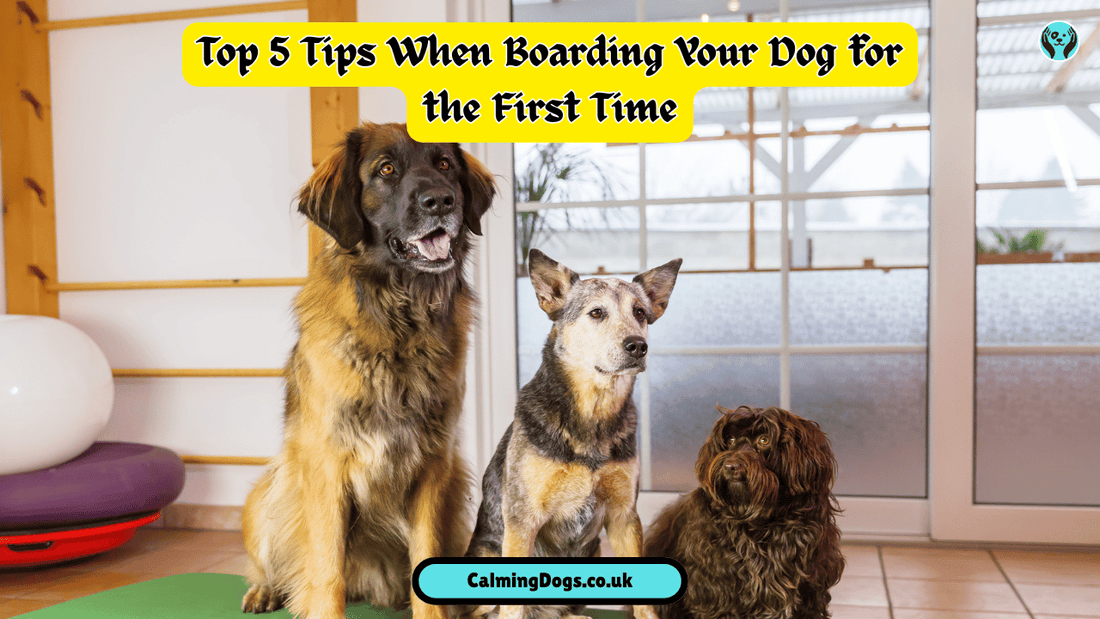
Top 5 Tips when Boarding your dog for the first time
Leaving your Dog for the first time is like sending a child off to summer camp—exciting, yet anxious! Having to board your dog, especially for first-time pet parents, may feel like the most sensible thing to do whether you are heading off for a work trip or going on vacation, but the worry of your pup will be safe and happy can linger.

However, the right preparation can help relieve stress for both you and your pup. This guide highlights five tips you need to ensure your canine companion enjoys a safe, fun, and stress-free stay when boarding your pet. Let’s dive in!
🐶 "You can send these Latest Dog Toys with your Dog" 🐶
1. Research Facilities Thoroughly (Don’t Just Google and Go!)
Finding the correct facility is vital for your dog. Search for literatural reviews and suggestions from your veterinarian or friends with dogs. Seek establishments with certified Staff, sanitary surroundings, and open guidelines.
What to Ask:
● “What’s your staff-to-dog ratio?”
● “How often are dogs exercised or socialized?”
● “What’s your protocol for emergencies?”
Common Mistakes to Avoid:
● Skipping a Tour: Always visit in person. Check for cleanliness, secure fencing, and whether dogs seem relaxed.
● Ignoring Gut Feelings: If a facility feels chaotic or unwelcoming, trust your instincts.
Pro Tip: Search for “Love your Dog Boarding” services that prioritize personalized care over mass kenneling.

2. Prepare Your Dog Mentally and Physically
Numbers have shown that dogs that are used to routine can develop kennel anxiety when sudden changes happen. To make the transition more seamless try out these steps:
● Practice Short Stays: Book a daycare session or overnight trial before a longer stay.
● Update Vaccinations: Ensure your dog is up-to-date on shots (e.g., bordetella, rabies).
● Pack Familiar Items: A worn T-shirt with your scent or their favorite toy can comfort them.
Also check: Collections for Dog
Avoid These Pitfalls:
● Introducing new food or treats right before boarding (risk of upset stomach).
● Overemotional goodbyes—stay calm to avoid transferring stress.
For example: If your dog puts up a fight every time you ask him to get in a crate then pick a facility that has open-play environments.

3. Communicate Clearly About Your Dog’s Needs
No one knows your dog better than you! Provide detailed instructions to the staff, including:
● Feeding schedule and portion sizes
● Medication requirements (with clear labels)
● Behavioral quirks (e.g., “Hates loud noises” or “Loves belly rubs”)
Mistakes to Avoid:
● Assuming Staff “Just Know”: Even small details matter.
● Overlooking Special Needs: Senior dogs or pups with separation anxiety may need extra attention.
Pro Tip: Write a one-page “cheat sheet” for the boarding team.

4. Address Kennel Anxiety Proactively
For first-time boarders, Kennel anxiety is actually very common. Use the following strategies to relieve stress:
● Pre-Boarding Exercise: A long walk or play session helps them relax.
● Calming Aids: Ask your vet about pheromone sprays or anxiety wraps.
● Positive Associations: Drop off a high-value treat (like a peanut butter-stuffed Kong) at check-in.
Warning Signs: If your dog becomes excessively stressed (evident by panting behavior, refusal to eat), talk to the facility about alternate arrangements.
For Example, facilities with webcams allow you to check in from afar, which gives peace of mind!
🐶 "You can send these Dog Care Products with your Dog" 🐶

5. Plan a Post-Boarding Reunion
Your dog will be excited to see you, but reintroduce routines gradually:
● Expect Temporary Changes: They might be extra clingy or sleepy.
● Monitor Health: Check for ticks, weight loss, or signs of illness.
● Reward Good Behavior: Praise them for handling the stay well!
Avoid: Overwhelming your dog with too much activity right after pickup.
Quick Checklist Before Boarding Your Dog
✅ Tour the facility and meet the staff
✅ Update vaccinations and pack medical records
✅ Label food, meds, and belongings clearly
✅ Share your dog’s routine and quirks
✅ Practice a short trial stay
FAQs About Dog Boarding
1. Can you board dogs in your home?
Ans: Yes! Many professional pet sitters offer in-home boarding, which can be less stressful than a kennel. Always verify their credentials and insurance.
2. How to prepare your dog for boarding?
Ans: Initially, book brief stays, stay calm at drop-off, and take familiar items, such as their bed or toys.
3. How much does it cost to board your dog?
Ans: Rates are 25–25–50 per night in a kennel, 40–40–100 in your home. The more structured and luxurious amenities you include the more you have to pay.
4. Does your dog have to be neutered to be boarded?
Ans: More than 50% of facilities want dogs to be spayed/neutered if over 6 months to prevent aggression or mating. Check policies in advance.
5. Is it bad to board your dog?
Ans: Not if you choose a reputable provider! Quality boarding offers socialization and supervised care. For dogs with severe anxiety, consider a pet sitter instead.
6. What if my dog refuses to eat at the facility?
Ans: Many dogs skip meals for the first 24 hours due to stress. Provide the staff with high-value toppings (e.g., shredded chicken) to entice them. If fasting lasts longer, request a vet check.
Conclusion:
Having your dog boarded for the first time can be nerve racking as a dog owner. A positive experience for your pup starts with choosing your facility wisely, preparing your pup, and making sure you communicate properly.
By the way: Some planning is all that is needed for your dog to have a feel at home— even when away from you. You’ve got this!